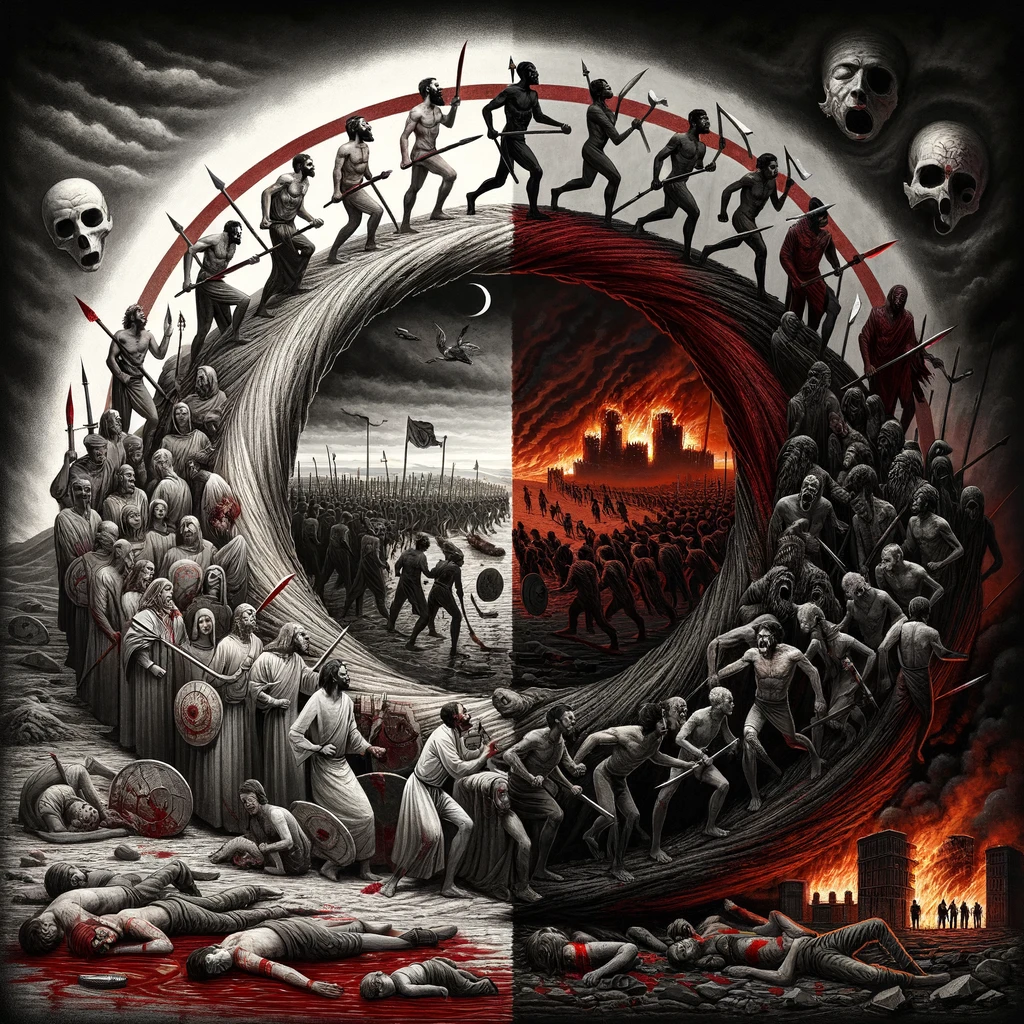
REVENGE : an eye for an eye, while primal and instinctive, often leads to destructive outcomes that reduce individuals, groups, and nations to the same level of barbarity as the original act of aggression. In seeking to right a wrong through revenge, people often perpetuate violence rather than achieving resolution or justice.
Here are some examples so we can illustrate and learn from the past how revenge manifests and how it can reduce individuals, groups, or even nations to the same level of barbarism as the original act of aggression:
1. Psychological Example: The Cycle of Abuse
In psychology, revenge is often seen as part of a vicious cycle of abuse. For instance, children who grow up in abusive households may develop deep-seated desires for revenge against their abusers. However, when these individuals act on those urges, they can perpetuate the cycle of violence, sometimes even becoming abusers themselves. This “revenge” doesn’t end the pain but instead creates new victims, often leading the person seeking vengeance to mirror the very acts they once condemned. In this way, seeking revenge can pull individuals down to the level of those who wronged them, keeping them locked in a primal, destructive loop.
2. Historical Example: The Punic Wars
A powerful historical example is the rivalry between Rome and Carthage during the Punic Wars. After Carthage was defeated in the Second Punic War, Rome exacted devastating revenge during the Third Punic War, utterly destroying the city of Carthage, killing or enslaving its people, and salting the earth to ensure it would never rise again. Rome’s relentless pursuit of vengeance brought the empire to the same level of brutality as the perceived aggressions of Carthage, illustrating how revenge can escalate to barbarism and annihilation, rather than achieving justice or peace.
3. Literary Example: “Moby Dick” by Herman Melville
In literature, revenge is often depicted as a consuming and ultimately self-destructive force. In Herman Melville’s Moby Dick, Captain Ahab’s obsession with exacting revenge on the whale that maimed him leads to his demise. His relentless pursuit of the whale draws not only himself but also his crew into destruction. Ahab’s revenge turns him into a figure as monstrous and dangerous as the whale itself, highlighting how revenge can dehumanize and drag individuals into moral darkness.
4. Political Example: The Rwandan Genocide
On a national level, the Rwandan Genocide serves as a tragic example of revenge spiraling into mass atrocity. Historical ethnic tensions between the Hutus and Tutsis erupted into one of the most horrific genocides in modern history, partly fueled by revenge for previous grievances and power struggles. The cycle of violence that unfolded shows how entire populations can be drawn into barbarism as revenge fuels hatred and retaliation. Here, seeking revenge on a mass scale led both perpetrators and victims to a level of violence and cruelty that obliterated any moral high ground.
5. Cultural Example: The Hatfields and McCoys Feud
In American folklore, the Hatfields and McCoys feud is a well-known example of revenge spiraling out of control. The conflict, which began over perceived slights and escalating acts of aggression, dragged both families into a decades-long series of retaliatory killings. The pursuit of revenge reduced both sides to lawlessness and violence, demonstrating how primitive the impulse for revenge can be when it becomes deeply embedded in cultural identity. Rather than resolving conflicts, revenge deepened the divide and perpetuated suffering on both sides.
But this are more recent examples, let’s go to the oldest ones :
These larger historical examples are powerful illustrations of how cycles of revenge, conquest, and retribution can shape entire societies over centuries. They highlight how the drive for revenge or domination can reduce nations to the same level of barbarism as their aggressors and have long-lasting, often tragic consequences.
1. The Arab Invasion of Spain (711-1492 CE)
The Arab (or Moorish) invasion of Spain in 711 CE is a classic example of a long-lasting conflict driven by conquest, retribution, and the desire for control. The Moors, who were largely Muslim, conquered large portions of the Iberian Peninsula, establishing a foothold in Europe that lasted nearly 800 years. This long period of conflict and rule came to an end with the Reconquista, a retaliatory effort by Christian Spaniards to reclaim the land. In their quest for revenge and religious purity, the Spaniards expelled or forcibly converted Muslims and Jews through brutal means, culminating in the Spanish Inquisition.
While the original act of aggression came from the Moors’ invasion, the Spanish response over centuries reflects how revenge and retribution can become national projects, reducing both sides to cycles of barbarism, forced conversions, massacres, and the eradication of cultures. The desire to reclaim Spain led to harsh persecution, which became a dark chapter in Spain’s history.
2. The Spanish Conquest of the Americas
The Spanish conquest of the Americas can be seen as an extension of this cycle of violence and revenge. After successfully driving the Moors out of Spain, Spanish conquistadors, emboldened by their religious zeal and imperial ambitions, turned to the New World. Figures like Hernán Cortés and Francisco Pizarro inflicted massive destruction on indigenous populations in their quest for wealth and power. The Spaniards replicated many of the brutal tactics used during the Reconquista in their treatment of the indigenous peoples of the Americas, including slavery, forced religious conversions, and mass killings.
The conquest of the Americas was, in some ways, Spain projecting its historical experience of subjugation and revenge onto a new context. In this case, the Spanish not only mirrored the violence they had suffered under Moorish rule but took it even further by completely eradicating entire civilizations, such as the Aztec and Inca Empires. The Spanish response to the indigenous people reflected the same ruthless drive for domination and retribution, ultimately leading to centuries of suffering and exploitation.
3. The Governor of Hispaniola and the Massacre of the Caribs
The story of the massacre of the indigenous Carib peoples under Spanish colonial rule in Hispaniola (modern-day Dominican Republic and Haiti) is another example of revenge and domination spiraling out of control. In the early years of Spanish colonization, the Carib peoples were seen as fierce and resistant to Spanish rule. The Spanish governor, in retaliation for their resistance and the threat they posed, ordered their systematic extermination. However, the massacre proved to be not only barbaric but economically costly.
In the aftermath of the decimation of the native populations, the Spanish were left with a labor shortage. This shortage led to the forced importation of enslaved Africans to work on plantations and in mines. The consequences of this cycle of violence, extermination, and slavery continue to reverberate throughout the Caribbean and the Americas today. The forced displacement of Africans set the stage for racial and social inequalities that persist across the Western Hemisphere, including the lasting impacts of racism and the legacy of colonial exploitation in North America, Central America, South America, and the Caribbean.
4. The Transatlantic Slave Trade and Its Consequences
The transatlantic slave trade, partly a result of Spain’s brutal conquest and colonization efforts, is one of the most tragic examples of how cycles of conquest and revenge can lead to barbarism on an unimaginable scale. As the European colonial powers (Spain, Portugal, Britain, and others) continued to colonize the Americas, they sought to maintain control over these vast territories by exploiting enslaved African labor. The violence inflicted on indigenous peoples by European conquerors was mirrored in the brutal treatment of African slaves.
This drive for economic dominance through the exploitation of human beings led to centuries of suffering, displacement, and social upheaval. The consequences of the transatlantic slave trade are still evident today in the systemic racial inequalities present in both the Americas and Europe. Entire societies were shaped by this cycle of violence and exploitation, creating deep divisions that remain difficult to overcome.
These historical examples reflect how cycles of revenge and domination often lead to even greater barbarism than the original acts of aggression. In seeking retribution or domination, individuals, groups, and nations frequently perpetuate cycles of violence that leave lasting scars on societies. Whether through the Arab conquest of Spain, the Spanish conquest of the Americas, or the horrific consequences of the transatlantic slave trade, the primal drive for revenge can escalate into centuries of exploitation, repression, and suffering. These legacies continue to shape modern societies, reminding us that while revenge may be primal, its consequences can be devastating and far-reaching.
